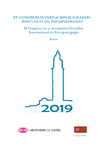¿Cómo evoluciona el modelo de ecosistema en el tránsito de Primaria a Secundaria?

Use this link to cite
http://hdl.handle.net/2183/38596
Except where otherwise noted, this item's license is described as Atribución-NoComercial-CompartirIgual 3.0 España
Collections
- Investigación (FEDU) [938]
Metadata
Show full item recordTitle
¿Cómo evoluciona el modelo de ecosistema en el tránsito de Primaria a Secundaria?Alternative Title(s)
How does the ecosystem model evolve in the transition from Primary to Secondary?Date
2019Citation
Val Rey, C., Martínez-Losada, C., & Bugallo-Rodríguez, Á. (2019). ¿Cómo evoluciona el modelo de ecosistema en el tránsito de Primaria a Secundaria? En M. Peralbo, A. Risso, A. Barca Lozano, B. D. da Silva, L. S. Almeida, & J.-C. Brenlla-Blanco (eds.), XV Congreso Internacional Gallegoportugués de Psicopedagogía: II Congreso de la Asociación Científica Internacional de Psicopedagogía (A Coruña, 4-6 de septiembre de 2019).
Abstract
[Resumen] Los modelos son un elemento clave en el proceso de enseñanza-aprendizaje de contenidos científicos. Conocer el modelo que presenta el alumnado da una idea de cómo piensa y de cómo relaciona los diferentes elementos. El presente trabajo es una investigación longitudinal que tiene como objetivo analizar la evolución del modelo de ecosistema durante la transición de Educación Primaria a Educación Secundaria. Para este estudio, se ha analizado el modelo de ecosistema que presentaban 17 alumnos de 6º de Primaria y de nuevo cuando cursaban 2º de Educación Secundaria. Como instrumento de recogida de datos, se elaboró un cuestionario con preguntas abiertas sobre distintos aspectos de la temática: biocenosis, interacciones con el medio, dinámica y transferencia. Para el análisis se elaboró un modelo escolar de referencia articulado en niveles de complejidad, cada sujeto fue analizado de forma individual para identificar su nivel de
adquisición. Finalmente, se ha comparado el modelo que cada individuo presentaba en cada curso, determinándose la evolución existente. El progreso observado es escaso o nulo, además, ningún modelo presenta la configuración cíclica de la dinámica ecosistémica, no comprenden el ciclo de materia y el flujo de energía como un proceso multidireccional. y son incapaces de reconocer su evolución. [Abstract] The models are a key element in the teaching-learning process of scientific contents. Knowing the model presented by the students gives an idea of how they think and how they relate the different elements. The present work is a longitudinal investigation that aims to analyse the evolution of the ecosystem model during the transition from Primary Education to Secondary Education. For this study, we analysed the ecosystem model presented by 17 students in the 6th grade of Primary and again when they were in 2nd year of Secondary Education. As a data collection instrument, a questionnaire was prepared with open questions on different aspects of the subject: biocenosis, interactions with the environment, dynamics and transference. For the analysis, a reference school model articulated in levels of complexity was elaborated, each subject was analysed individually to identify their level of acquisition. Finally, the model that everyone presented in each course has been compared, determining the existing evolution. The observed progress is scarce or null, in addition, no model presents the cyclical configuration of the ecosystem dynamics, they do not understand the matter cycle and the energy flow as a multidirectional process. and are unable to recognize their evolution.
Keywords
Modelos
Transición educativa
Ecosistemas
Models
Educational transition
Ecosystems
Transición educativa
Ecosistemas
Models
Educational transition
Ecosystems
Editor version
Rights
Atribución-NoComercial-CompartirIgual 3.0 España
ISBN
978-84-9749-726-8






